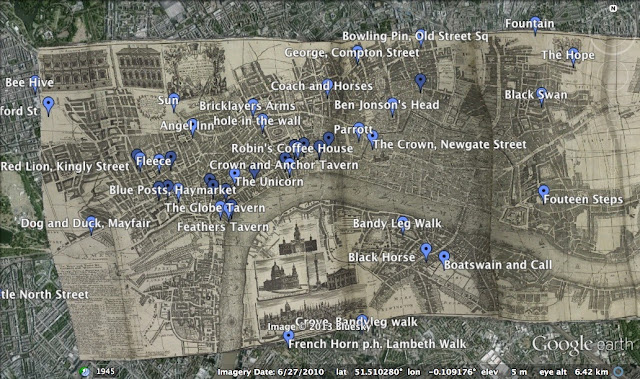London Corresponding Society pubs mapped
Ian Newman of UCLA runs a great blog on the pubs used by the London Corresponding Society in the 1790s. http://lcspubs.blogspot.co.uk/
He's mapped the pubs on a google map, and so I took the kml file and mapped it on an 18th century map of London (unfortunately only from 1736 - I would love this to be mapped on http://www.locatinglondon.org/ or on a more contemporary map of London, but none were available on http://maps.nypl.org/warper/)
Here's what it looks like.
John Barrell, in his book The Spirit of Despotism, has also mapped the spaces of the LCS. But I think the best description of the LCS's reach is still by E. P. Thompson, in the opening section of The Making of the English Working Class:
The LCS was a process, a constantly evolving meeting point, a channel and a place.
Just as a rough point of contrast, here are the places mentioned in the trials for the Gordon Riots, using Locating London's Past:
He's mapped the pubs on a google map, and so I took the kml file and mapped it on an 18th century map of London (unfortunately only from 1736 - I would love this to be mapped on http://www.locatinglondon.org/ or on a more contemporary map of London, but none were available on http://maps.nypl.org/warper/)
Here's what it looks like.
 |
| LCS pubs mapped on 18thc map of London |
At one end, the London Corresponding Society reached out to the coffee-houses, taverns and dissenting churches off Piccadilly, Fleet Street and the Strand where the self-educated journeyman might rub shoulders with the printer, the shopkeeper and the engraver or the young attorney. At the other end, to the east and south of the river, it touched those older working-class communities – the waterside workers of Wapping, the silk-weavers of Spitalfields, the old dissenting stronghold of Southwark.
For Thompson, the
LCS was not simply a political society: it was a point of connection for
different groups across London defined by their socio-economic identities –
their place – in a way that hadn’t been achieved before:
(the Making, 1968 ed., p. 23)‘New theories, new arguments, have generally first effected a junction with the popular movement in London, and travelled outwards from London to the provincial centres. The LCS was a junction point of this sort... And we must remember that its first organizer lived in Piccadilly, not in Wapping or Southwark’.
The LCS was a process, a constantly evolving meeting point, a channel and a place.
Just as a rough point of contrast, here are the places mentioned in the trials for the Gordon Riots, using Locating London's Past:
 |
| Locating London's Past, keyword search for 'riot', 1780-1, mapped on 1746 map |

Comments
Post a Comment